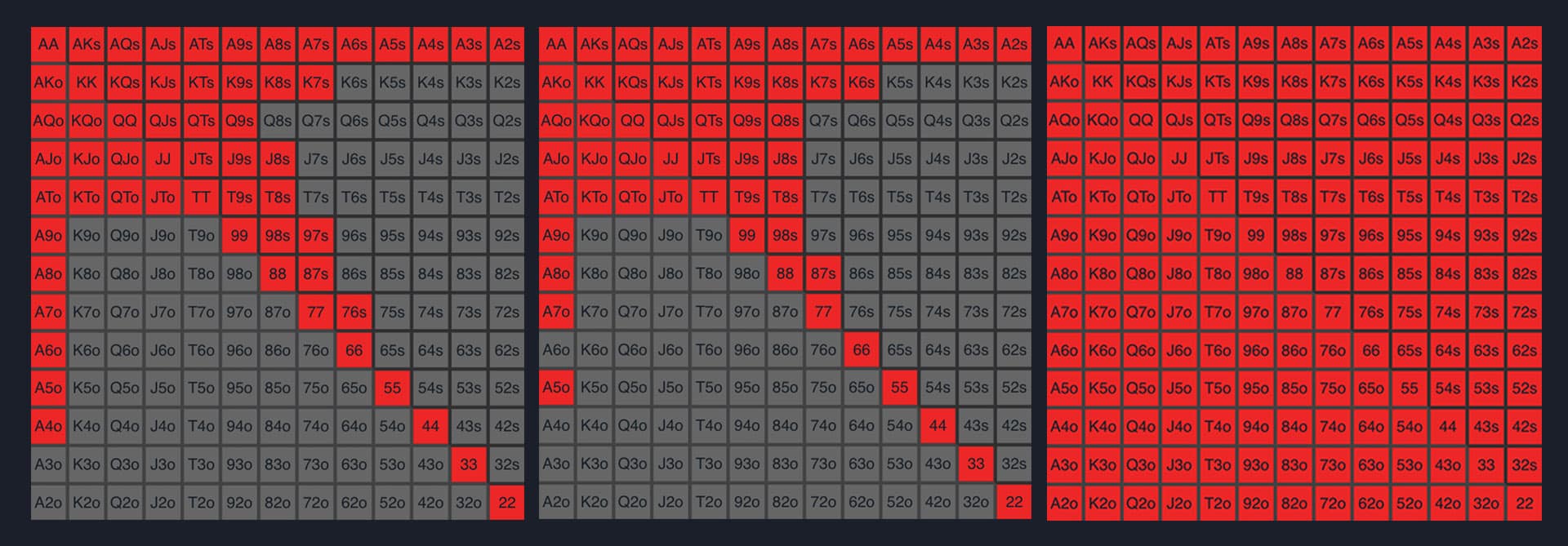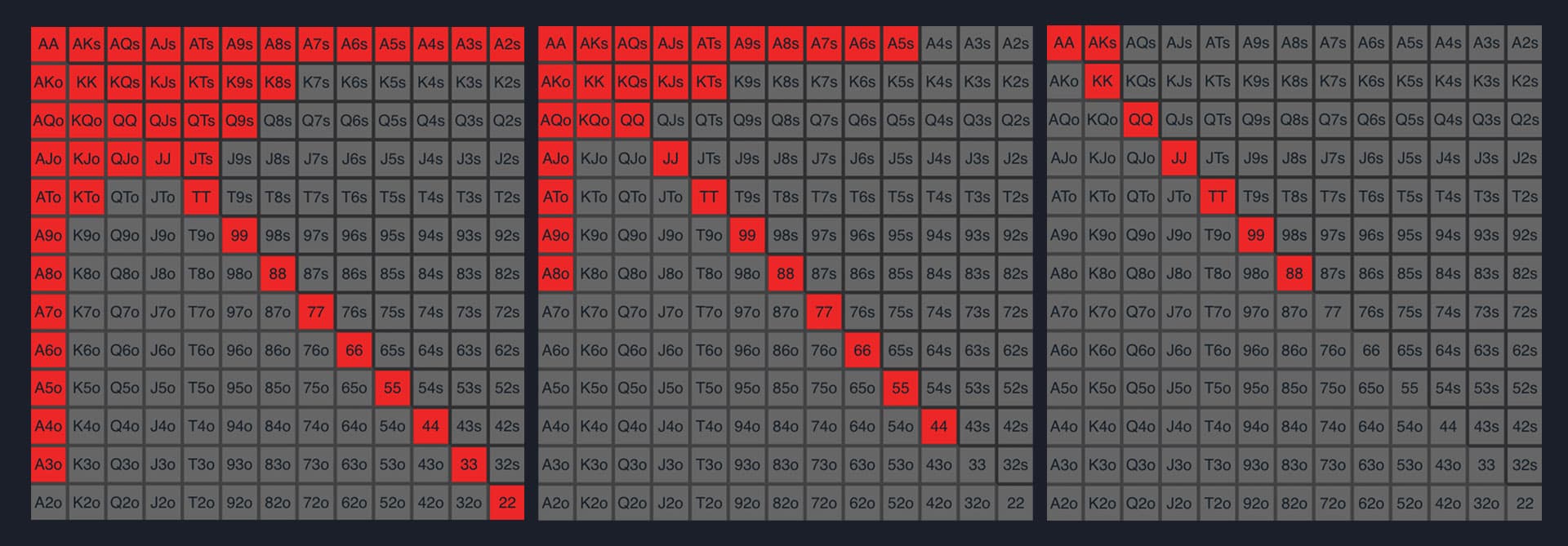Have you ever heard the claim that the late stages of poker tournaments are not “real poker” because these contests become “shove-fests”? It is a fairly common complaint, particularly from those playing tournaments with fast structures. However, while some players regard this as a flaw of tournaments, here at Red Chip Poker we see an exciting opportunity. Indeed, this is a primary factor in why we added push-fold charts to the Red Chip Poker GTO Ranges app.
The increasing blinds of tournaments produce a decrease in the average stack, as expressed as a multiple of the big blind. Consequently, players invariably reach a point in a tournament when their only sensible decision is to fold their hand preflop or to move all in. The latter may occur either through “open shoving” or by calling an opponent who has shoved themselves. One key takeaway from this article is that you far prefer to be the shover and not the caller. We will explain why that is below.

It seems likely that the criticisms of this “push-fold” realm stem from the fact that, once two players have committed their chips, the outcome of the hand relies purely on the run-out of the cards. As a result, you may hear players assert that success during this phase of a MTT is simply a matter of luck. The reality, however, is completely different. Knowing which hands to shove and which to call is what generates long-term profit in these spots. And any successful poker tournament player has solid push-fold ranges that they employ at the tables.
You can find such ranges for free on the internet. Some are even reliable. But nearly all such free resources of which we are aware fall down on two important points. First, and as developed in this article, the assumptions that go into creating these charts are rarely explicitly stated. This can result in players applying poor ranges for the situation in which they find themselves. Second, understanding when and how to deviate from push-fold charts constitutes a major skill edge that will greatly increase your bottom line.
The remainder of this article details the assumptions we used in creating push-fold ranges for the Red Chip Poker GTO Ranges app, along with a more general discussion of how to apply these ranges at the table. We highlight the implications of some of these results, and also address extrapolations and exploitative deviations from these GTO solutions. You may also enjoy a synopsis of some of the results in this quick video by SplitSuit.
When Poker Met Game Theory
If you have any interest in poker theory, you are likely aware that the last half dozen years or so have seen an explosion in strategy developments stemming from game theory. So-called “GTO” (game theory optimal) solutions include preflop ranges and postflop, multi-street betting lines returned by the omniscient solvers. Here’s a quick video by SplitSuit reviewing what such GTO solvers actually do.
Unless you are a tournament player, you may not be aware that GTO solvers were first applied to late-stage MTT play more than fifteen years ago. As noted above, this phase of tournaments is invariably a one-street affair, requiring much less computing power than multi-street, deeper-stacked cash games. Hence it was natural that such situations first came under the microscope of iterative game-theory algorithms.
Single table sit-n-goes (SNGs) are particularly amenable to such analysis, thanks to the limited number of players and fixed pay-out structure. Indeed, analysis on this poker format was so thorough that by 2007 some well-known SNG practitioners claimed that “SNGs are solved.” In other words, all the information was available to play SNGs essentially perfectly. This would have rendered the format completely unplayable were it not for the fact many poker players refuse to study the game.
Tools such as HoldemResources Calculator (HRC; used for the Red Chip app), ICMizer, and others have continued to evolve since their introduction, and serve as key tools for MTT players to improve their late-game play. Red Chip Poker content creator Ben Hayles is an HRC expert, and provides an overview of the software in the following video.
You can use HRC as a powerful leak-finding tool in your tournament play, and as a means of creating push-fold (and higher-level) ranges for the late stages. As is so often the case with poker, however, devils lurk in the details. It is one thing to use HRC to analyze a preflop hand after it has occurred, but how do we generate push-fold charts ahead of time? This is a nuanced question that we now address.
Push-fold charts: assumptions, simplifications and ICM
In most cash-game GTO solutions, such as the preflop ones featured on the Red Chip GTO Ranges app, it is assumed that all players at the table have 100bb stacks. As the standard buy-in for online cash games, this assumption is both natural and applicable, particularly since it makes it likely the effective stack at many tables will be of this depth.
The situation in tournaments is rather more complex. After hours of play, stacks around the table can vary considerably. The impact this has on push-fold ranges depends on another factor unique to tournaments: there is not a one-to-one correspondence between chip value and a player’s cash equity in the prize pool.
Fortunately, there is a mathematical model that relates chip EV and $EV known as the Independent Chip Model (ICM). This model is incorporated into tools like HRC so that push-fold solutions accurately provide ranges that maximize profit rather than chips. As we discuss further below, there are common situations in which “ICM pressure” is so strong that, when facing an all-in, our calling range becomes vanishingly small.
ICM also provides a limitation on the reliability of any push-fold charts. Specifically, the precise pay-out structure, number of players remaining, and the stack-depth distribution of the remaining players can have a profound effect on ranges
Here is a simple, albeit extreme, example. Assume you’re playing a satellite tournament. There are seven players remaining with the top six only getting the same prize. You have 15bb, the two players to your immediate left each have 4bb, and the player to your right has 30bb. Suppose it is your big blind, and the action folds to the deep-stacked small blind who shoves on you. You look down at AA. Do you call?

Absolutely not. There is no point in even looking at your cards in this configuration. You are likely a massive favorite over the small blind, and will usually win the hand if you call, but when you get outdrawn it is an absolute disaster. The presence of the two short stacks to your left mean you figure to make more money in the long-term by folding everything and waiting for one of them to bust.
Satellite bubbles are a somewhat pathological situation that we explore further below, but this example does illustrate that “ICM pressure” can lead to extremely tight preflop folds. More generally, a preflop GTO solution that only accounts for chip EV cannot be applicable to all, or even most, late-game tournament situations. If you are currently using free resources from the web that provide shoving and calling ranges at a range of stack depths, be aware that short-cuts and assumptions are necessarily a feature of such ranges. Under certain conditions, such push-fold ranges can be wildly inaccurate.
Red Chip Poker GTO Ranges App
Our primary aim with MTT push-fold ranges both within CORE and on our GTO ranges app is to provide representative ranges for common late-stage tournament situations. That said, it will be apparent from the above discussion that any such ranges are unlikely to apply perfectly to a specific situation in which you find yourself. We will first explain the assumptions that went into the ranges, then turn to their practical application at the tables.
We first assumed that everyone at the table is at the same stack depth. This is the only sensible assumption for generic ranges. Further, to a first approximation, one can use the effective stack at the table when employing these ranges. As we explain below, sometimes that short-cut simply is not good enough, and recognizing such spots constitutes part of the skill of late-game tournament play.

The stack depths used for the calculations were 5bb, 7bb, 10bb, and 15bb. For each of these depths, we calculated push-fold ranges for three “strengths” of ICM: no, low, and high.
The no-ICM case is self-explanatory and corresponds simply to the equilibrium solutions in which ICM is ignored. In other words, these are the push-fold ranges appropriate for chip EV.
For the low-ICM case, we followed the convention of assuming a 9-handed table with a 50/30/20 pay-out structure. The resulting ranges thus apply perfectly to a full-table SNG, but this simplification also produces a reasonable approximation to ICM effects in large-field MTTs when the bubble is approaching.
And this is when the details we alluded to earlier muddy the waters. What exactly does an “approaching bubble” mean? Unfortunately, the details of the pay-out structure can matter a lot. However, with some convergence both live and online to long-tailed pay-out distributions paying 15%-20% of the starting field, our experiments indicate the ranges work well once more than about 60% of the starting field has been eliminated. Before that point you can revert to the no-ICM case.
The high-ICM case was included as a resource for satellite and survivor tournament players, as well as to highlight how impactful ICM can become to ranges on hard money bubbles. Specifically, we again took a nine-handed table in which the top six players all received the same cash prize, with the remainder getting nothing. In other words, the situation is diluted from a pure bubble in a satellite, but clearly shows how nutty (and nutted) these high-ICM ranges can be.
Example ranges from the RCP GTO Ranges app
To make this discussion more concrete, let’s look at a specific range set from the app and CORE. The first panel below shows the open-shoving range from hijack (two off the button) at 10bb for our ICM cases of no, low and high (left to right), described above.

The corresponding calling ranges from the big blind are shown in the panel below, again with ICM of no, low and high extending from left to right.

The high-ICM shoving chart makes a blunt but important point. Satellite structures have such profound ICM effects that we can shove any two cards even from hijack. Note too the narrowness of the corresponding calling range on the right of the second panel.
For this particular set of assumptions, however, the no-ICM and low-ICM comparisons may be somewhat counter-intuitive. You will notice these ranges have slightly different shapes, but a similar number of combos. This runs counter to the common notion that, as ICM pressure increases, we can shove wider. The high-ICM case illustrates that with extreme ICM pressure we can indeed shove really wide, but this trend is absent when going from no- to low-ICM.
If you have studied other GTO preflop solutions, you will likely be aware that the details of the equilibrium solutions are not always easy to understand. What appears to be going on here is that the narrower calling ranges in the low-ICM case are impacting the shoving ranges. With four players left to act behind the hijack, the probability of getting called by a strong hand is balancing the effects of fold equity, thereby keeping the shoving range fairly tight.
Similar trends can be seen when analyzing final table push-fold ranges. Specifically, typical pay-out structures often produce slightly narrower shoving ranges when ICM effects are directly included than for chip EV ranges. And in detail, the precise distribution of stacks can have a profound influence, particularly when the presence of a very short stack means laddering by folding can generate a significant pay jump.
Additional technical details about the creation of push-fold ranges in the RCP GTO Ranges app are provided in this article.
Conclusions And Your Push-Fold Homework
Generic push-fold charts provide a critical baseline to start your investigation of late-game shoving and calling ranges. Those offered by Red Chip have the added advantage that the assumptions upon which they are based are clearly stated. However, it should be apparent from the above discussion that becoming an expert in late-stage MTT play requires more than these charts.

There are two general methods you might employ to improve your push-fold ranges. The first is brute-force drilling. If you are a devotee of SplitSuit’s workbooks and have benefitted from them, this is likely to work well for you. Take a tool like HRC and set-up your own push-fold scenarios. Investigate
how uneven stack distributions impact push-fold ranges. Experiment with different pay-out structures. The patterns that emerge from such work will greatly enhance your intuition in these spots.
A complementary approach is simply to analyze push-fold spots that crop up in the tournaments you play. This is particularly straight-forward for online players since HRC and similar calculators include the ability to input entire hand histories. A leak-finder report can then be generated, highlighting your major errors. Many people find that analyzing hands they have actually played is a more engaging method of doing this kind of work.
If you do take this second approach, see what happens as you modify the stacks, allowing for significant variations in stack depths at the table. The impact of such uneven stack distributions can be particularly important when one is already in the money, notably when pay jumps are significant. This is something many players appreciate intuitively: if there are multiple short stacks in danger of busting, letting them do so to move up the pay-out ladder has considerable merit. The wonderful aspect of using analytical tools to investigate these spots is that your intuition can be quantified.
Equally importantly, use the range editing function to see how your ranges vary if your opponents are not adopting equilibrium ranges themselves. An example of such a situation is given in this article that discusses memorizing ranges. Overfolding or underfolding opponents (relative to equilibrium) can have a profound effect on your shoving ranges.
There really is no end to the investigative work you can carry out, and the improvements it will bring to your tournament game. We believe strongly that, for a tournament player, work of this nature is by far the most valuable in terms of the ratio of effort to reward.
Ultimately, inputting the pay-out structure for the specific tournament you are playing can greatly refine the Red Chip push-fold charts for the games you play and thus improve your results. Outside of fixed-field multi-table SNGs, this can be difficult, but far from impossible. For example, if you’re planning on playing a live weekly tournament at a specific casino, in most markets you can use the Bravo app to see the field size and pay-outs. Simply check out the numbers for the week before you play.
And as always, if you would like to discuss push-fold ranges, or any other poker topic, please join us on the Red Chip Poker Discord server.

